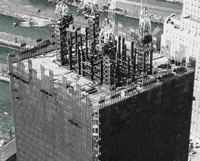 home > wtc > plausibility > concrete dust
home > wtc > plausibility > concrete dust
Amount and volume of fine dust
Summary

WTC core columns
In a simple gravitational building collapse, as architect Richard Gage points out, at the end of it, there's stuff at the bottom. Stacks of fallen floors. To paraphrase Gage, wouldn't you expect to see one or two or fifty floors, all broken and piled up? You wouldn't expect to see, erm, absolutely nothing. Which is what there was, practically. Two 110 story buildings collapse due to fires and gravity, and at the bottom where there ought surely to be a massive pile of rubble, there's a few scraps of metal and lots of dust.
Concrete doesn't instantly and totally turn 100 percent into fine powder from falling; even if you dropped one whole floor from the top of the WTC, there'd be plenty of chunks bigger than 10 micron dust particles. Steel columns aren't broken into bits and hurled outward with great force for hundreds of feet by gravity. Note that the explosion of fine dust occurs instantly, at the very onset of the collapse, before the gravitational smashing even has a chance to account for any dust. The towers just instantly explode into dust, quite literally.
Jim Hoffman is a physicist who has looked carefully into this issue. Bear with us for a few details here. According to Griffin: "Hoffman begins by calculating the energy required to pulverize the approximately 90,000 tons of concrete in the North Tower into 60 micron powder (which produces a very conservative figure, he points out, 'since some reports indicate the average particle size was closer to 10 microns than 60 microns'). He then calculates 'the energy needed to expand the dust clouds to several times the volume of each tower within 30 seconds of the onset of their collapses' (a calculation that also produces a conservative figure, because it ignores the continued expansion after 30 seconds). Providing two alternative calculations (based on different assumptions about the major cause of expansion), he concludes that the energy source had to provide either 2,682,000 or 11,700,000 KWH. This would mean that the energy required, even by his conservative calculations, would have been from 24 to 106 times greater than the amount of gravitational energy available (111,000 KWH)."
The extra energy had to come from somewhere, and explosives seems the best, if not the only, imaginable candidate.
Source: David Ray Griffin, The New Pearl Harbor, p. 178-179
Jim Hoffman, see 911research.wtc7.net
Richard Gage, Architects and Engineers for 9/11 Truth
Analysis
Hoffman's calculations are good, but I don't even need them to understand that falling floors wouldn't instantly explode into fine dust before they've even had a chance to hit anything, as they did on September 11.
Here's how I see it: At the bottom, there wasn't much in the way of concrete. No floors stacked up like pancakes. It was all dust. So if you want to believe the pancake piledriver theory, then you have to believe that the whole stack of pancakes turned instantly into dust the moment it all hit the ground. Except for all the bits that turned to enormous clouds of propelling dust in the air right away. Giant stack falling, giant stack falling, poof, all dust. If on the other hand each floor turned into dust the moment it hit the floor below, then there's no pile driver; then we're saying a giant cloud of dust made all those steel columns collapse and fly outwards for hundreds of feet. See what I'm saying?
Plus, if, whatever, the floors let loose from their moorings and fell, why wouldn't they fall down on each other and leave the enormously strong cross-braced steel columns standing, in the hugely substantial core at least? What is there about falling concrete that smashes steel columns completely into nice evenly severed chunks? I think, in the battle of steel versus concrete, my money is on steel. See what I'm saying?
It very obviously does not make sense and as such it is extremely suspicious.



Here's how I see it: At the bottom, there wasn't much in the way of concrete. No floors stacked up like pancakes. It was all dust. So if you want to believe the pancake piledriver theory, then you have to believe that the whole stack of pancakes turned instantly into dust the moment it all hit the ground. Except for all the bits that turned to enormous clouds of propelling dust in the air right away. Giant stack falling, giant stack falling, poof, all dust. If on the other hand each floor turned into dust the moment it hit the floor below, then there's no pile driver; then we're saying a giant cloud of dust made all those steel columns collapse and fly outwards for hundreds of feet. See what I'm saying?
Plus, if, whatever, the floors let loose from their moorings and fell, why wouldn't they fall down on each other and leave the enormously strong cross-braced steel columns standing, in the hugely substantial core at least? What is there about falling concrete that smashes steel columns completely into nice evenly severed chunks? I think, in the battle of steel versus concrete, my money is on steel. See what I'm saying?
It very obviously does not make sense and as such it is extremely suspicious.
Bottom line, me, I give it:




Discussion
You must log in if you wish to add a comment. Register here if you need login information.
People's Court
Quotes
The official explanation that the Twin Tower collapses were gravity-driven events appears insufficient to account for the documented energy flows.-- Jim Hoffman, 911research.wtc7.net
Currently showing comment 1 of 1 total comments.
1. sunny 11 Jan 2008 09:31:06 PM
I am absolutely on board with this -- too much dust, not enough weight.